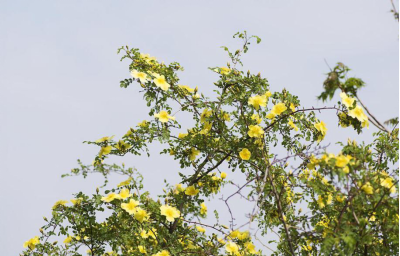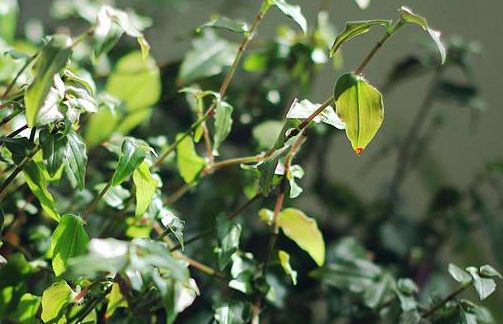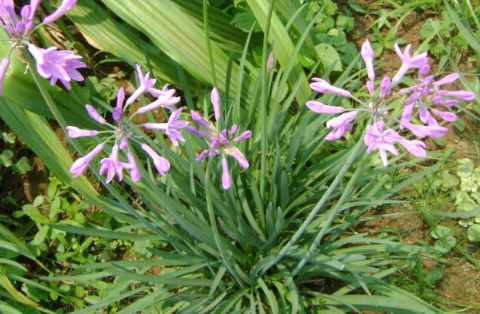Matters needing attention in breeding Rosa przewalskii
1. Fertilization
First of all, it is necessary to apply one or two spades of rotten compost as base fertilizer in the cave where the yellow thorn rose seedlings are placed. It should be noted that more branches need to be pruned and watered thoroughly after planting, and then watered again every 3 days or so, which can greatly improve the survival rate of yellow thorn rose seedlings. After Huang Ci Mei survives, it is generally not necessary to apply fertilizer, but in order to make it flourish, topdressing can be applied every other year after flowering.
Second, watering
In the daily management of Huangximei, it should be watered in time according to its drought condition, so as to avoid death caused by excessive drought and lack of water or watering too frequently. In the rainy season, we should pay attention to drainage and waterlogging prevention, and we need to irrigate the anti-freezing water again before frost.

3. Pruning
In order to reduce the nutrient consumption after flowering, the flower branches should be pruned in time and the residual flowers and abortive branches should be removed. Before sprouting, the leaves should be pruned in combination with ramets, and the withered branches and overdense thin and weak branches should be cut off to make them grow vigorously. One or two-year-old branches should be cut as little as possible so as not to reduce the number of flowers.
IV. Other
Rosa roxburghii is usually cultivated from late March to early April. At the same time, it is worth noting that yellow thorn mei needs to be planted with soil balls, that is, when transplanting yellow thorn roses, the seedlings dug out do not knock out the entangled mud from the roots, and after cutting off part of the roots, trim the muddy root into the shape of a ball. This can ensure the absorption of inorganic salt and water by the root of yellow thorn rose, and greatly improve the survival rate of yellow thorn rose.
From this point of view, Huang Rosa is a kind of plant that is easy to feed. But even if the plant is easy to feed, it will get sick, so how to take care of the sick Huang Rosa?
Culture methods and matters needing attention of Rosa przewalskii
Soil requirements for culture methods of Rosa davidiana
Yellow thorn rose in the growth of soil requirements are not strict, more tolerant of drought and barren, but also can grow in alkaline soil. But because yellow thorn rose is not resistant to waterlogging, so the soil requires good drainage, as far as possible loose and breathable.
Water and fertilizer management
When planting Rosa przewalskii, it is necessary to apply some rotten compost as base fertilizer, and no more fertilizer is needed after survival, but in order to make it flourish, topdressing can be applied every other year after flowering.
Yellow thorn rose should be watered once after planting, and then watered once every 3 days or so, and then it can survive. In daily management, water should be watered in time according to drought, so as to avoid wilting or even death caused by excessive drought and lack of water. Pay attention to drainage and waterlogging prevention in the rainy season, and irrigate once anti-freezing water before frost.
Pruning
Yellow thorn roses should be pruned frequently.
Pruning should be carried out after flowering, and the residual flowers and dead branches should be removed to reduce nutrient consumption.
Pruning after falling leaves or before sprouting, cut off old branches, withered branches and overdense thin and weak branches to make them grow vigorously. The 1-year-old and 2-year-old branches should be cut as little as possible so as not to reduce the number of flowers.
Matters needing attention in Culture of Rosa davidiana
Rosa przewalskii is propagated by means of ramet propagation, striping propagation and cuttage propagation.
Rosa przewalskii has strong tillering ability, so it is suitable to propagate by the method of plant division, because the method of plant division has the advantages of fast seedling formation, high survival rate and the same double petal character of the plant.
Disease
Yellow thorn rose has the advantages of easy cultivation, extensive management and less diseases and insect pests. Generally speaking, the harm of powdery mildew will appear in the growth process of Rosa przewalskii, which is mainly characterized by pathological changes on both sides of the leaves and sparse powdery mildew layer, which distorts the leaves and turns the young leaves purple-brown and withered.
Introduction to the culture method of Rosa davidiana and the matters needing attention in the culture.
Do you know how to get to Huang Cimei? Yellow thorn rose is a golden flower with a charming fragrance. In May, it is time for Huang Ci Mei to be in full bloom. It has a high ornamental value, and the flowers are very beautiful when they bloom. Today I will take you to learn about the breeding method of Huang Rosa.
Culture method
1. Soil
Yellow thorn rose in the growth of soil requirements are not strict, more tolerant of drought and barren, but also can grow in alkaline soil. But because yellow thorn rose is not resistant to waterlogging, so the soil requires good drainage, as far as possible loose and breathable.
two。 Water and fertilizer
When planting Rosa przewalskii, it is necessary to apply some rotten compost as base fertilizer, and no more fertilizer is needed after survival, but in order to make it flourish, topdressing can be applied every other year after flowering. Yellow thorn rose should be watered once after planting, and then watered once every 3 days or so, and then it can survive. In daily management, water should be watered in time according to drought, so as to avoid wilting or even death caused by excessive drought and lack of water. Pay attention to drainage and waterlogging prevention in the rainy season, and irrigate once anti-freezing water before frost.
3. Pruning
Pruning should be carried out after flowering, and the residual flowers and dead branches should be removed to reduce nutrient consumption. Pruning after falling leaves or before sprouting, cut off old branches, withered branches and overdense thin and weak branches to make them grow vigorously. The 1-year-old and 2-year-old branches should be cut as little as possible so as not to reduce the number of flowers.
4. Reproduction
The multipurpose method of breeding and cultivation is to cut the branches again, leaving only 30ml / 50cm, and then use a sharp knife or axe to split the roots. When splitting roots, pay attention to separate clumps of plants should have 3 Murray 5 branches, all branches should have good roots. In addition, the strip pressing method can also be used to propagate; in recent years, the method of rooting of cuttings has been found out, mainly that the cuttings should increase the bottom temperature and maintain a high humidity, so that the roots can grow well in more than a month, and the cultivation of yellow thorn rose should choose the sunny and dry place. shaded places often grow weak because of lack of light, flowers are reduced and flowers are small, and there are not so many petals.
5. Diseases and insect pests
Yellow thorn rose has the advantages of easy cultivation, extensive management and less diseases and insect pests. Generally speaking, the harm of powdery mildew will appear in the growth process of Rosa przewalskii, which is mainly characterized by pathological changes on both sides of the leaves and sparse powdery mildew layer, which distorts the leaves and turns the young leaves purple-brown and withered.
Matters needing attention
1. When newly planted, some organic fertilizer should be applied properly. Those who re-cut ramets and those who have good management of water and fertilizer after planting will be able to bloom well in the second year. After the flower fade, it is appropriate to cut off the residual flowers together with some branches, which can not only keep the plants clean and tidy, but also promote new branches. Old branches should also be properly re-cut and renewed.
2. Rosa przewalskii is easy to cultivate, but avoid waterlogging. When planting, the pit should apply less base fertilizer, step on it after sealing the soil, pour water through it, and cultivate soil to protect it. Cut off weak and withered branches before sprouting in spring every year. Perennial twigs can also be thinned or truncated. If there are often harms of diamondback moths and caterpillars in the growing season, attention should be paid to prevention and control.
The above are the breeding methods and matters needing attention of Rosa davidii. I hope it can be helpful to the majority of flower friends. Please continue to pay attention to the succulent flower bed and learn more about flower conservation.
- Prev

Hydroponic culture of wedding dress hanging orchid
1. Choose a container because it is hydroponic, so the choice of container should be more strict. Although any container that can hold water is OK, it is best to choose a transparent container. What are the advantages of this? First of all, a transparent container can make it easier for us to better observe its root growth.
- Next

The Propagation method of Zijiao Flower
Sowing and breeding Zijiao flower sowing is to collect seeds in autumn and store them to sow in spring. After entering autumn, small bulbs can be formed and can be dug out and planted separately. But it takes many years for the seedlings to blossom. Bulb propagation usually grows some small bulbs on the periphery of the stem disk of the old bulb, but the bulbs can be separated from September to October.
Related
- Fuxing push coffee new agricultural production and marketing class: lack of small-scale processing plants
- Jujube rice field leisure farm deep ploughing Yilan for five years to create a space for organic food and play
- Nongyu Farm-A trial of organic papaya for brave women with advanced technology
- Four points for attention in the prevention and control of diseases and insect pests of edible fungi
- How to add nutrient solution to Edible Fungi
- Is there any good way to control edible fungus mites?
- Open Inoculation Technology of Edible Fungi
- Is there any clever way to use fertilizer for edible fungus in winter?
- What agents are used to kill the pathogens of edible fungi in the mushroom shed?
- Rapid drying of Edible Fungi

